Life and Works of Rizal
Chapter 1: Introduction: Republic Act 1425 |
|---|
Lesson 1: On Hero and Heroism |
|---|
What is a Hero?
Someone who is admired for his or her achievements and noble qualities and regarded as an ideal or model
Central figure in an event, period or movement, honored for outstanding qualities
Someone who showed great courage and benevolence
What makes an individual good or evil?
Things that could foster evil to an individual includes:
Dehumanization
Diffusion of responsibility
Obedience to authority
Unjust system
Group pressure
Moral disengagement
Anonymity
Factors or reasons that possibly foster someone as good or heroic:
More compassionate or empathetic
Perhaps a hero gene
Level of oxytocin → Paul Zack
An american neuroeconomist
“Love hormone” in the brain ↑ the likelihood of someone demonstrating altruism
Philip Zimbardo
Explored the nature and roots of heroism
Defined heroism: “an activity with several parts”
Performed in service to others in need
Engaged in voluntarily
Act going beyond what is asked
Heroic act is one performed with recognition of the possible risks — actor is willing to accept sacrifices
Act without external gain
Other Research on Heroism:
The very same situation that inflame the hostile imagination in some people – making them villains, can also instill the heroic imagination in other people – prompting them to perform heroic deeds
E.g. Holocaust
Christians who helped the Jews were the same with,
Civilians who helped imprisoned or kill Jews, or ignored their suffering
“There is no clear line between good and evil. Instead, the line is permeable; people can cross back and forth between it”
M.C Escher
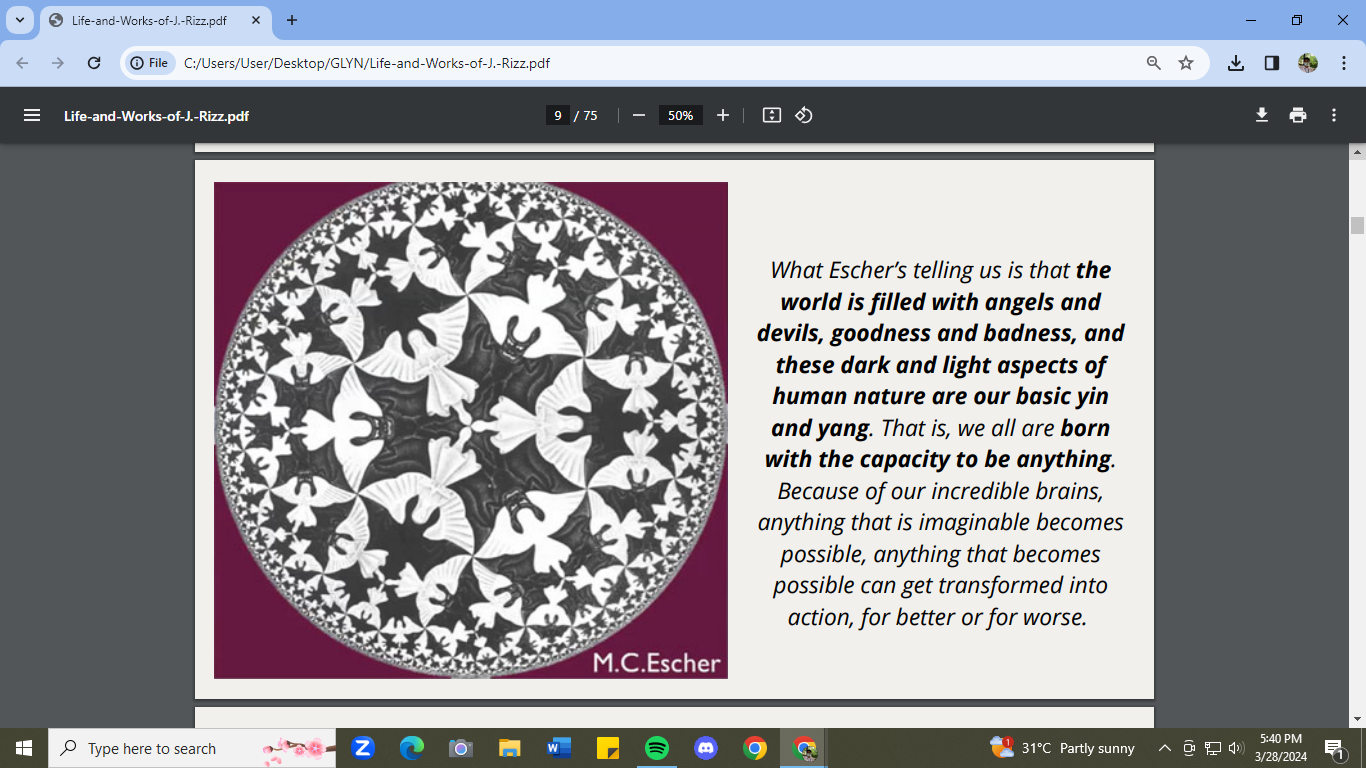
“The world is filled with angels and devils, goodness and badness, and these dark and light aspects of human nature are our basic yin and yang.”
“We are all born with the capacity to be anything.”
NOTE:
We are all born with tremendous capacity to be anything, and we get shaped by our circumstances, which are accidents of birth:
family
culture
time period
Whether we grow up in a war zone vs peace; or if we grow up in poverty rather than prosperity.
Each of us possess the capacity to:
Do terrible things, or have
An inner hero
Once stirred, it is capable of performing tremendous goodness for others
Between the two extremes of good and evil, in the bell curve of humanity are the masses or the general population who does nothing
Refuse to call to action
Implicitly support the perpetrators of evil
Who will set the criteria for the recognition of the national hero?
NO law, executive order, or proclamation has been enacted or issued officially proclaiming any Filipino historical figures as a national hero
Due to significant roles in the process of nation building and historical contribution – there were laws enacted honoring them
BUT, according to historians, heroes SHOULD NOT BE LEGISLATED
Appreciation to the them should be better left to academics
Acclamation for heroes would be recognition enough
Executive Order No. 75: “National Heroes Committee” |
|---|
Issued by Pres. Fidel V. Ramos – March 28, 1993
create a National Heroes Committee under the Office of the President
Principal duty:
To study, evaluate and recommend Filipino national personages / heroes in due recognition of their sterling character and remarkable achievements for the country.
Criteria:
Heroes are those who:
have a concept of nation and thereafter aspire and struggle for the nation’s freedom.
define and contribute to a system or life of freedom and order for a nation.
contribute to the quality of life and destiny of a nation.
NHC Technical Committee
November 15, 1995
adopted the criteria submitted by Dr. Alfredo Lagmay
As follows:
A hero is part of the people's expression, but that process of a people's internalization of a hero's life and works takes time, with the youth forming part of that internalization
A hero thinks of the future, especially the future generations.
The choice of hero involves not only the recounting of an episode or events in history, but of the entire process that made this particular person a hero.
On the same year the committee selected the following figures to be recommended as heroes:
Jose Rizal
Andres Bonifacio
Emilio Aguinaldo
Apolinario Mabini
Melchora Aquino
Marcelo H. del Pilar
Sultan Dipatuan Kudarat
Juna Luna
Gabriela Silang
Lesson 2: Understanding the Rizal Law |
|---|
Republic Act No. 1425 or The Rizal Law
was passed in 1956
It is the mandatory teaching of Jose Rizal’s life with the emphasis on his landmark novels
all educational institutions in the Philippines to include in their curricula courses on the LIFE, WORKS, AND WRITINGS of Jose Rizal
The law was proposed by Sen. Claro M. Recto – in 1995
On April 17, 1956, then Senate Committee on Education Chair Jose P. Laurel sponsored the bill.
The Law was heavily debated in its time
The Rizal Law was passed in June 1956
Context:
“Whereas, today, more than other period of our history, there is a need for a rededication to the ideals of freedom and nationalism for which our heroes lived and died.”
This document was written in the year 1956 during Magsasyay’s regime
the country was still recovering from the Japanese occupation and still very dependent on US governance
Ideals of freedom and nationalism were very essential during those times – and was still gradually developing its national identity and integrity
It reignites the lost patriotism and nationalism
Patriotic Objectives:
To recognize the relevance of Rizal’s ideals, thoughts, teachings, and life values to present conditions in the community and the country and apply them in the solution of day-to-day situations and problems of contemporary life;
To develop an understanding and appreciation of the qualities, behavior, and character of Rizal as well as his thoughts and ideas, and thus foster the development of moral character, personal discipline, citizenship and vocational efficiency;
To comply with the patriotic objectives of the Rizal Law given by the late Senator Jose P. Laurel.
From Rizal Bill to Rizal Law
On April 3, 1956, Senate Bill No. 438 was filed by the Senate Committee on Education.
On April 17, 1956, Senate Committee on Education Chair – Jose P. Laurel sponsored the bill and began delivering speeches for the proposed legislation.
The bill became controversial – the Catholic Church began to express opposition against the bill. A major point:
whether the compulsory reading of the texts: Noli Me Tangere and El Filibusterismo, appropriated in the bill was constitutional
the call to read the unexpurgated version was also challenged
on May 9, 1956, Senator Jose P. Laurel proposed amendments to the bill to move its progress
Why Did the Catholic ChurchOppose the Rizal Law?
almost 70 years after the publication of Noli Me Tangere, the Church still viewed Rizal’s novels as blasphemous
Catholic Church of 120 years ago used the same influence in preventing the novels to be read by Filipinos
Manila Archbishop Rufino Santos penned an impassioned pastoral letter protesting the bill
read on all masses
Manila Mayor Arsenio – allegedly walked out of the mass
those who opposed the Rizal Bill painted Recto as communist and anti-Catholic
According to Abinales and Amoroso (2005)
Church feared the bill would violate freedom of conscience and religion
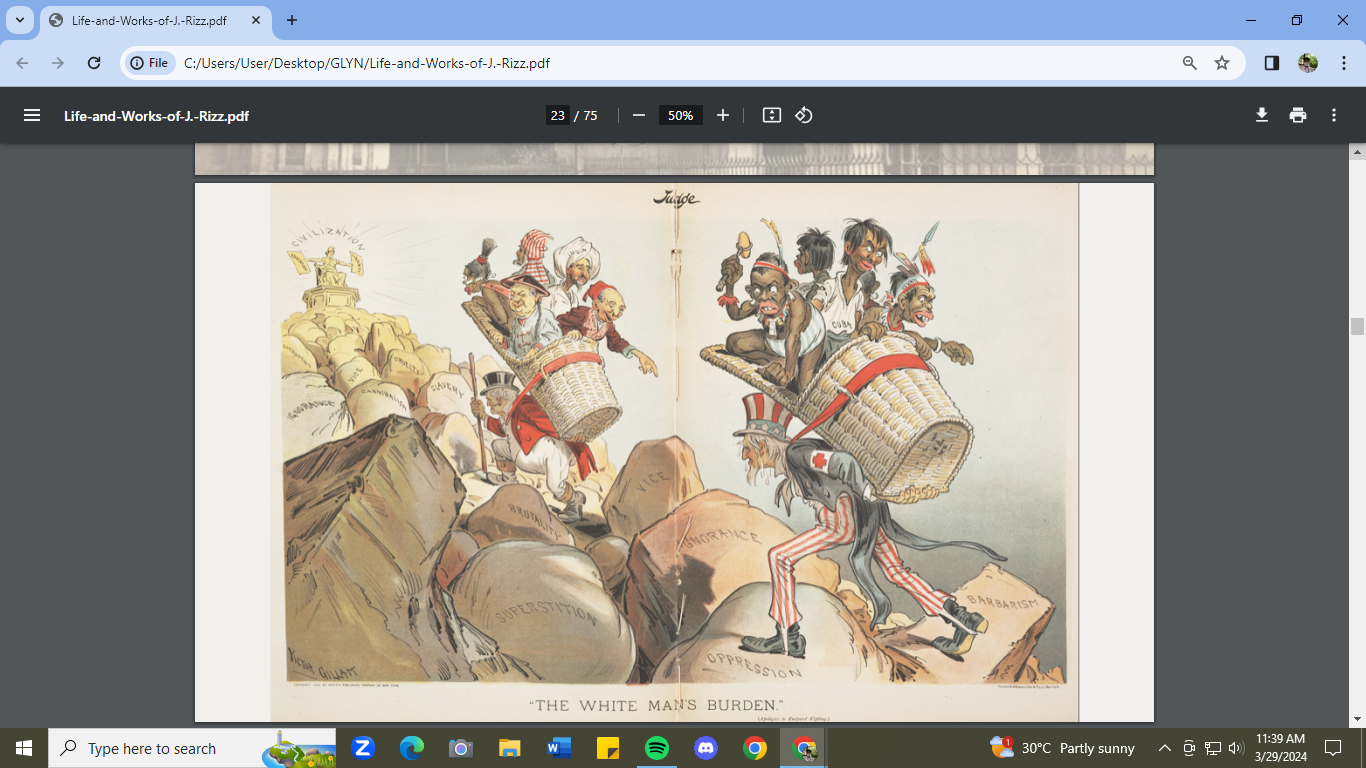
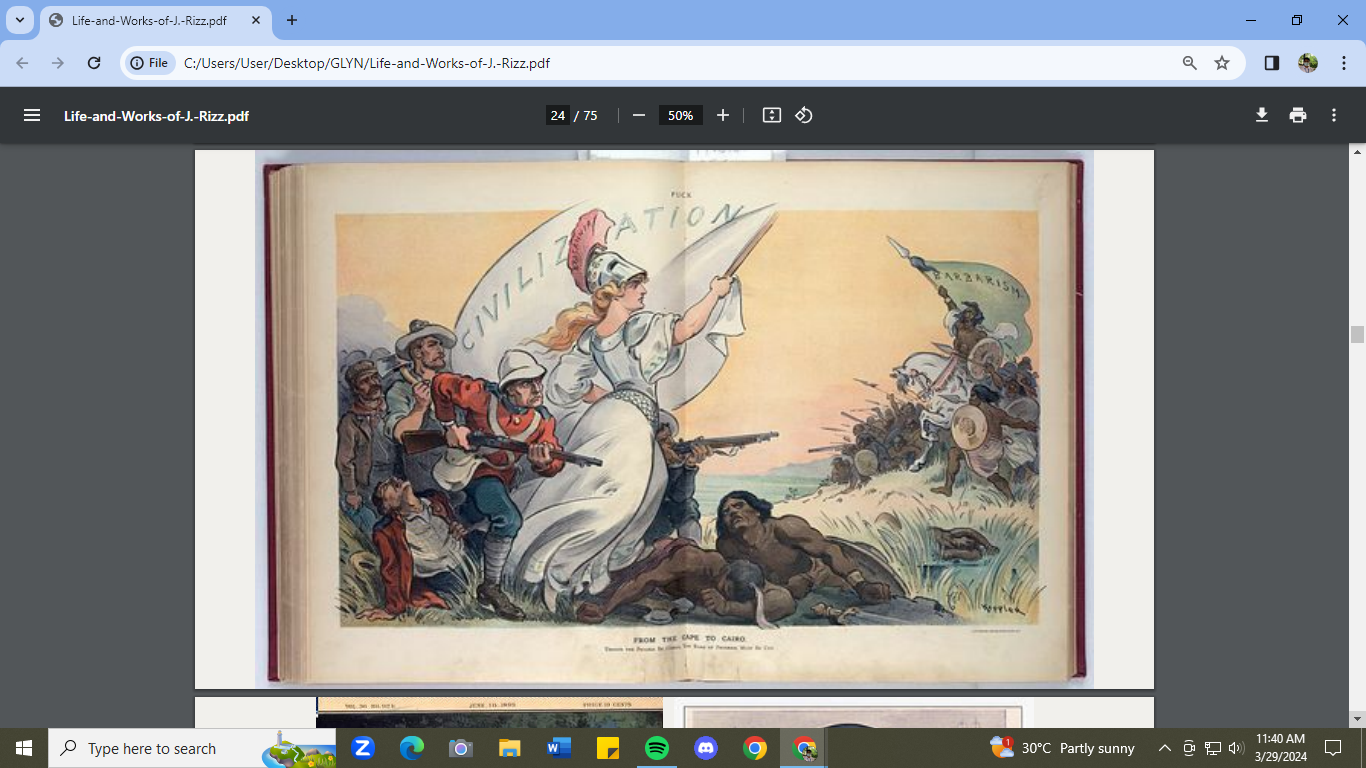
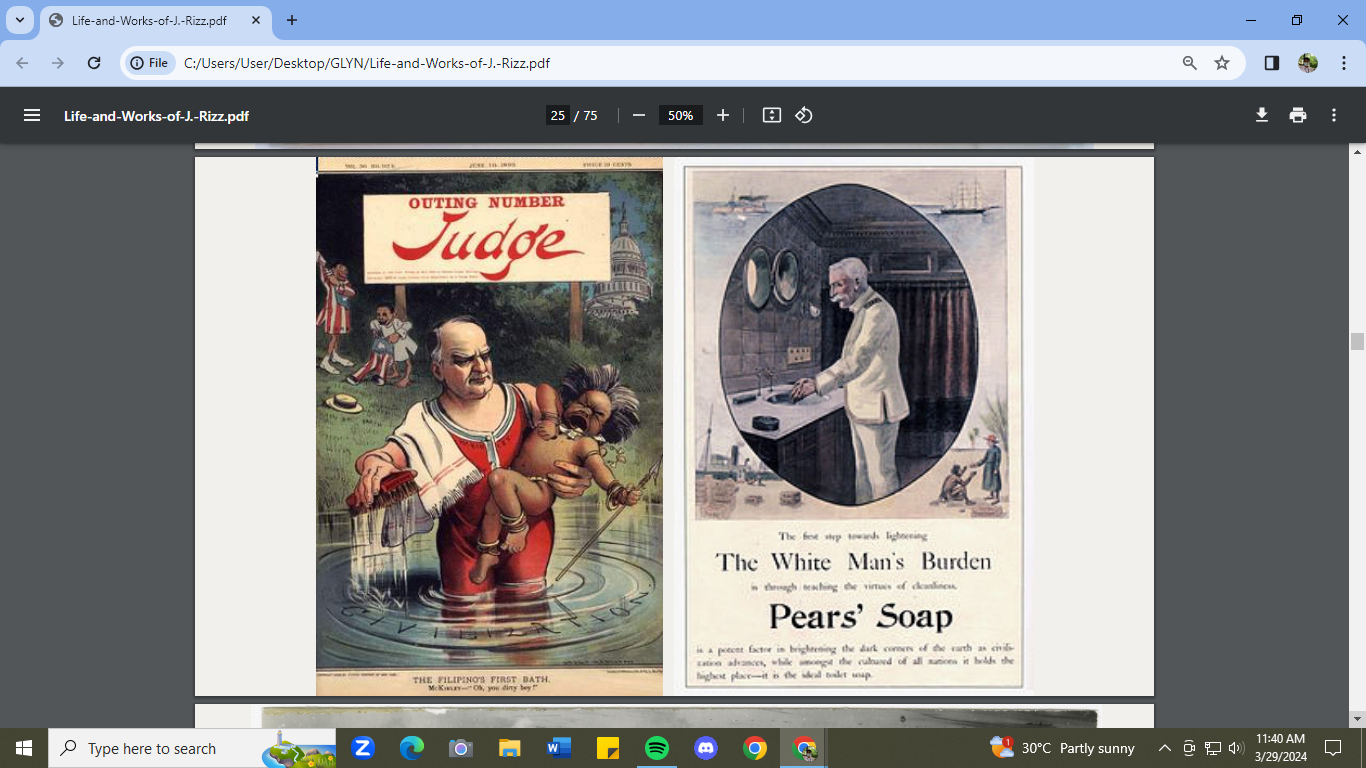
Module 2: Spanish-era Philippines and the development of Filipino Consciousness and Nationalism |
|---|
Historical Background of the 19th Century: Spain and Philippines |
|---|
Pre-Colonial Philippines
innumerable institutions that predate the coming of Islam, Christianity and colonialism, most interesting includes:
Traditional socio-political organization
Leadership and Governance
Landholding practices
Conflict and Conflict Resolution
Value System
Religion
8th-15th centuries the Philippine Islands
part of a great Hindu-Malayan empire ruled from Java and Sumatra
Negritos, proto-Malay, and Malay peoples were the principal peoples
Negritos are believed to have migrated by land bridges
some 30,000 years ago, during the last glacial period
Filipino ancestors, despite idiosyncrasies, had developed an essentially homogenous culture
Onofre Corpus:
“...our ancestors evolved an essentially homogenous culture…Nature was a primary factor. Overall, community life through the archipelago was influenced by, and responded to the common ecology. The geographically benign tropical climate and the largely uniform flora and fauna favored similarities, not differences.”
Recap to Philippine History
Prior to the time of European contact
Most major islands had rich political landscape, consisting of polities or
Chiefdoms of different economic scale and hierarchical complexity
Barangay was the social unit
Name was based on the Malay term Balangay – a boat
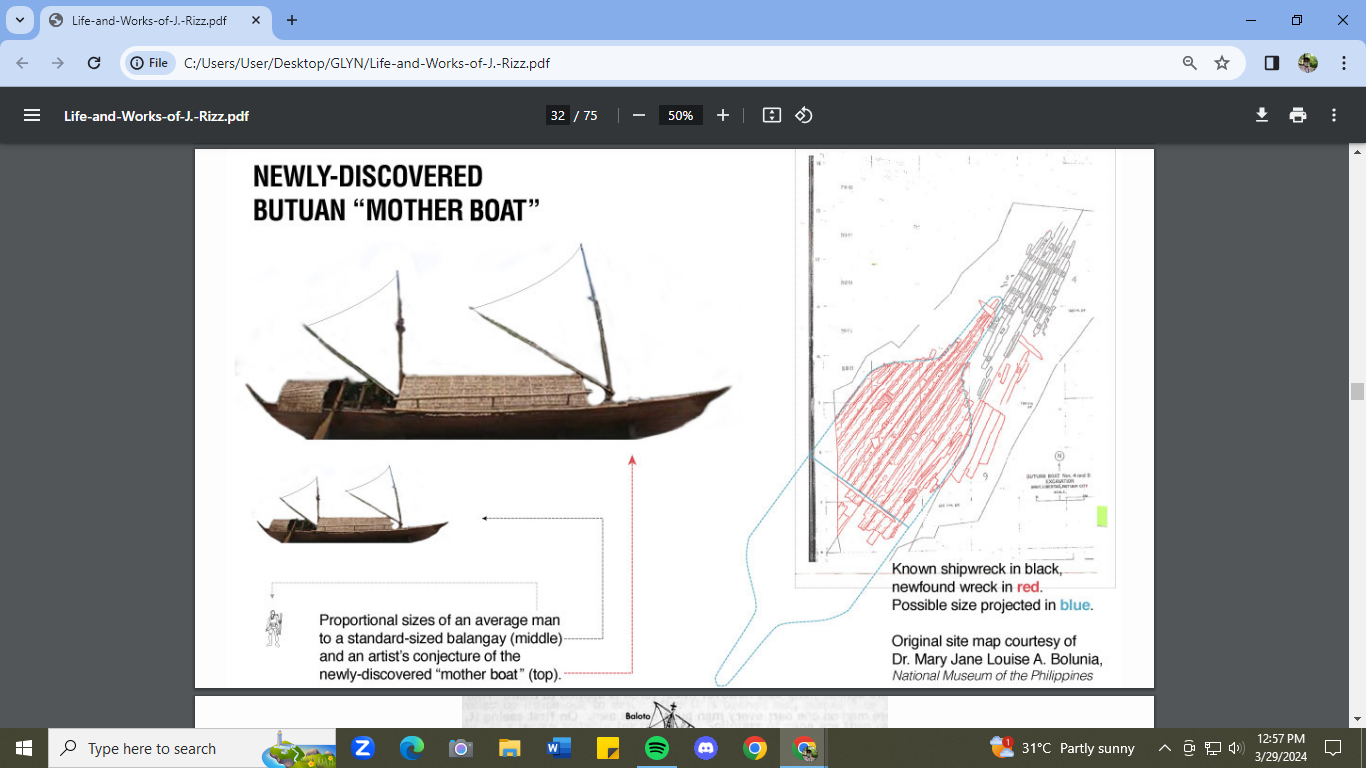
Spanish Colonization in the Philippines
Leyes de las Indias
First code of colonial laws
Compiled by ecclesiastical authorities – medicated or clerical orders of the Catholic Church
Gold, God, and Glory”
The motive generating the overseas exploration, expansion, and conquest
Allowed various European countries to structure “geopolitics” and to rise the world superpower
Encomienda System
Introduced in 1570
Legaspi distributed lands in Cebu to loyal Spanish subjects
Encomiendero are the men who received the favor of land
Repartimiento de Labor
Allowed for forceful labor
Policies were implemented to keep the Filipinos in political subjection – also to exploit the country’s natural resources, manifested in:
Taxation system
Force labor
Galleon trade
Government monopolies
Agricultural and Trade policies
19th Century Spanish Philippines Taxation
Required the conquered people to render tribute
recognition of Spanish sovereignty
From 1571 - 1884
Filipinos paid tribute to Spain
Amounting 8 reales or 1 peso
Payable in cash or in kind
1589
Tribute was increase → 10 reales
Turned 12 reales in 1851
1884
Reform decreeing to abolish the tribute
Government instituted the personal cedula tax
Graduated poll-tax based upon the income of the taxpayer
Bandala
The government required each province to meet quota of commodities assigned to it
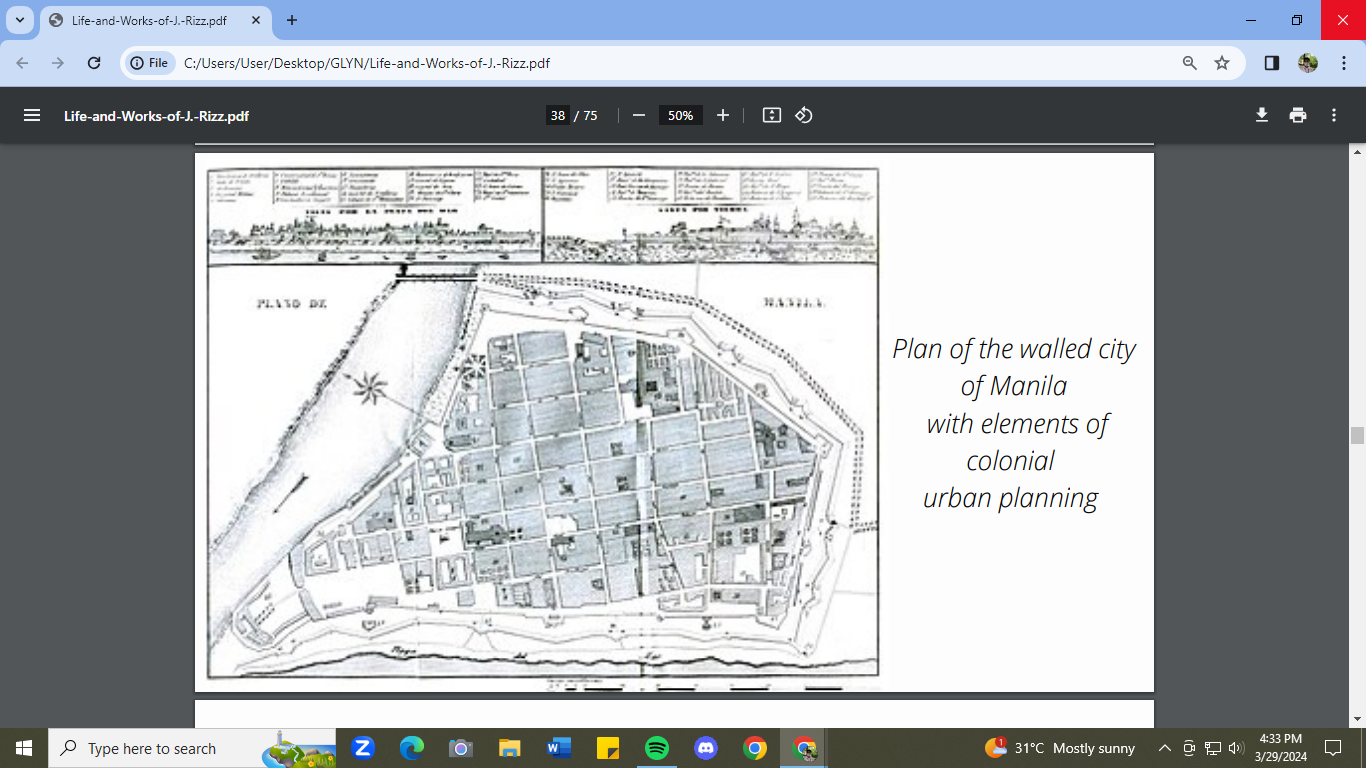
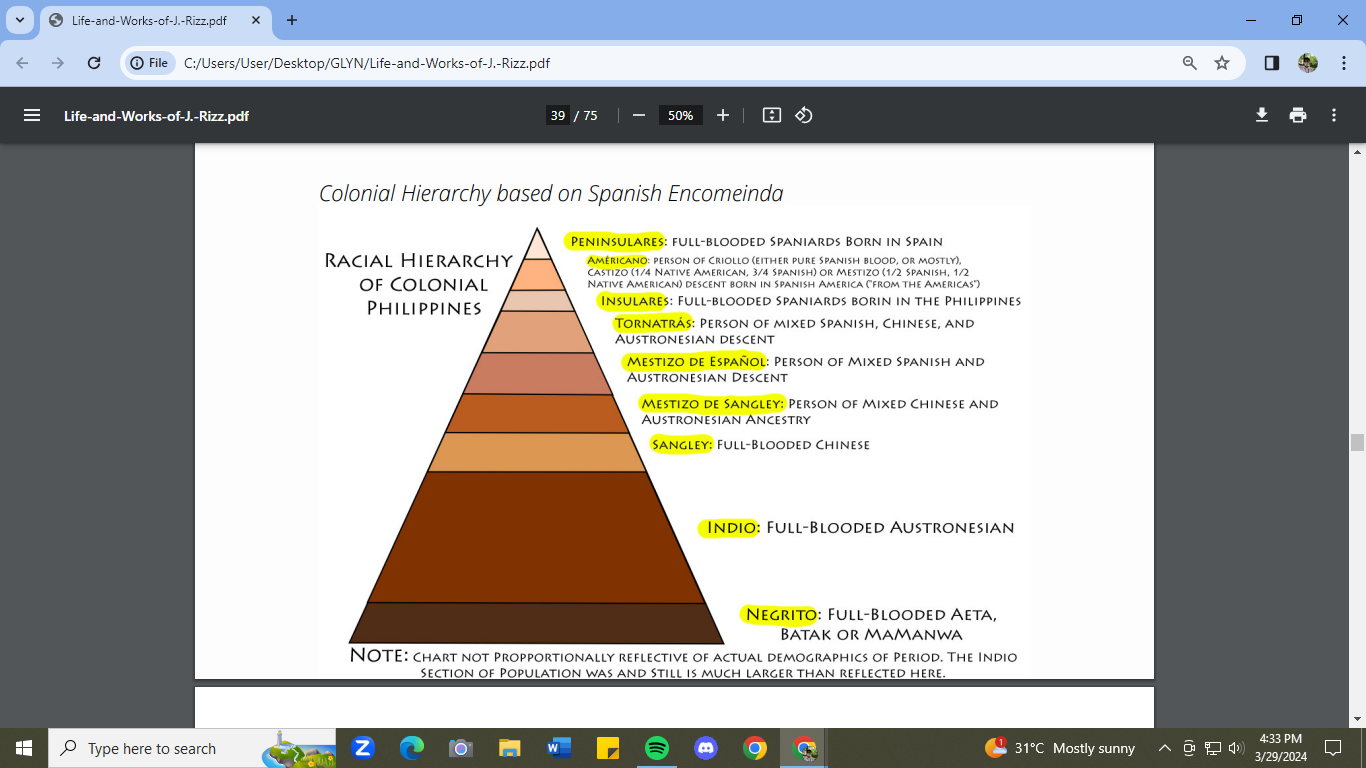
Eliodoro Robles in The Philippines in the Nineteenth Century summarized these problems in the Following:
The lack of technical and qualified personnel;
The inability of many communities and provinces isolated by geographical features to raise their own fund;
The unbridled use of power on the part of local officials, resulting in rampant abuse and miscarriage of justice;
The rise of brigandage and social restlessness rendering local police ineffective;
The inadequacy of public improvements and general services;
The rationality of balancing ecclesiastical power…and of secularizing public instruction (including the teaching of Spanish) to make it more functional rather than dogmatic;
The need for more economy in administration;
The necessity of extending effective authority and control over “frontier: areas…; and
The need for promoting agriculture industry
Conditions in Spain
1808, Napoleon invaded Spain and deposed King Fernando VII
Absolutism returned Spain changed into a different forms of government
Military
Constitutional
Liberal
Republic (1868 - 1873)
The Reformation
Protestant Reformation on 16th Century
Religious, political, intellectual and cultural upheaval – Catholic Europe
Martin Luther, John Calvin, and Henry VIII
Challenged papal authority
Questioned the Catholic Church's ability to define Christian practice
Argued for a political and religious redistribution of power
Into the hands of Bible and pamphlet reading Pastors and Princes
Secularization of Parishes
In 1770 a royal decree was issued
Effect the transfer of parishes from Spanish regulars who belong to the religious orders to the seculars who belong to the different dioceses
Some parishes were transferred to Filipino priests
Friars refused to hand-in majority of the parishes
Adjunct to the issue
Friars are negligent of their duties
Friars are occupied with amassing wealth and lands
In 1826, Filipino seculars demanded for secularization of the parishes
They have been asking for more than ½ century
Some people would sympathize to the priests woes
Philippines within the Orbit of World Trade
In 1834 the Philippines was opened to WT
Caused a great impact to Filipinos
It brought economic relief to poor colonials
Exposed Filipinos for the first time to various developments
The opening led to the rise of the Middle Class
Native entrepreneurs composed it, later form the principalia
Principalia families sent their children to colleges and universities
Exposed Filipino students to political thoughts:
Locke and Rousseau
Ideals of French Revolution (1787-1799; climax: 1789):
Liberty
Equality
Fraternity
Opening of the Suez Canal in Egypt in 1896
Further contributed to the accessibility of Europe to Filipinos
Governor-General Félix Berenguer de Marquina
recommended that the King of Spain open Manila to world commerce
Bankruptcy of the Real Compaña de Filipinas (Royal Company of the Philippines)
catapulted the Spanish king to open Manila to world trade
In a royal decree issued on September 6, 1834
the privileges of the company were revoked and the port of Manila was opened to trade
Economic Development
End of the galleon trade
Opening of the Suez Canal
Opening of the Philippine port to the WT
Rise of export crop economy
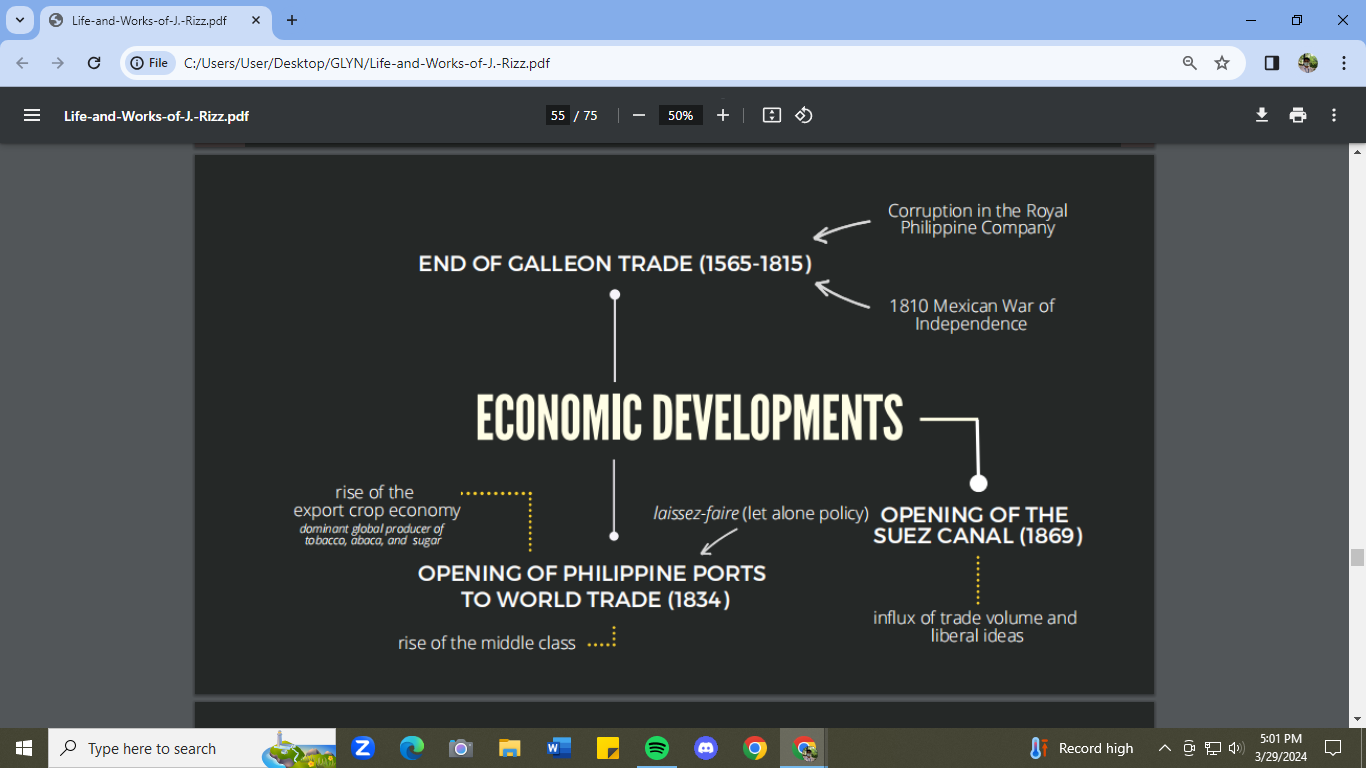
Social Transformation
Education reforms
Rise of the Middle Class
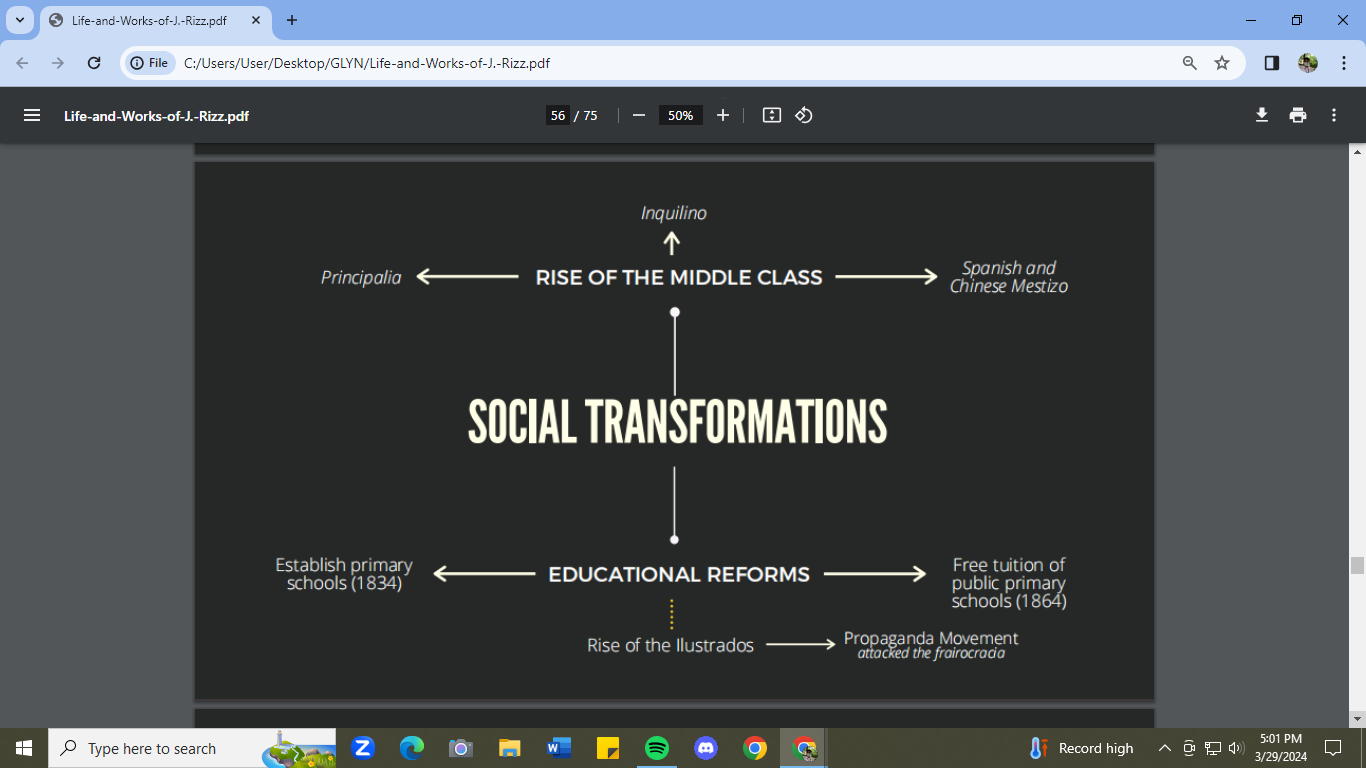
Political Reforms
Liberalism
Bourbon Reforms
Cadiz Constitution
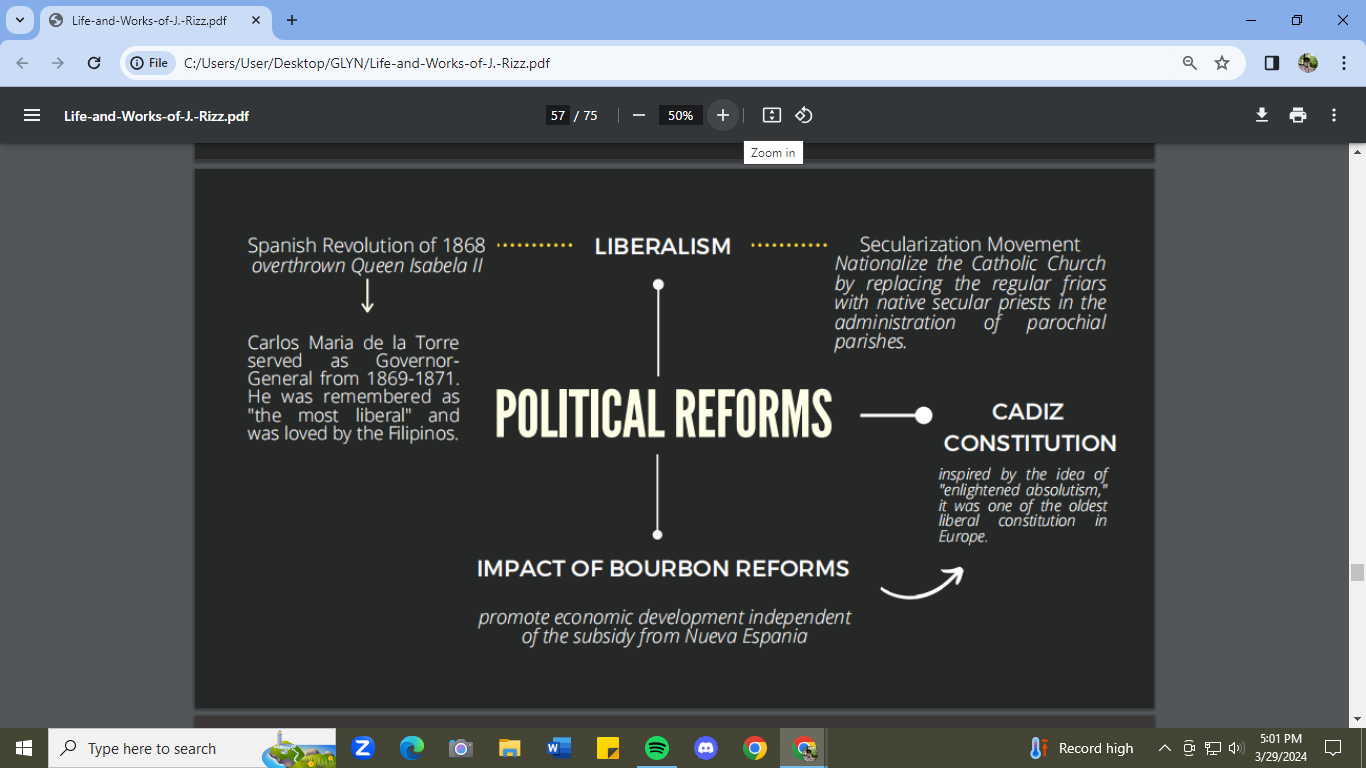
CARLOS MARIA de la TORRE
Carlos María de la Torre y Navacerrada
a soldier and politician
Carlist army Officer
served as Governor-General of the Philippines from 1869 to 1871
most beloved of the Spanish Governors-General ever assigned in the Philippines
sent by Francisco Serrano
After the ouster of Queen isabel II
Result of La Gloriosa Revolution
considered a liberal Spaniard
practiced the liberal and democratic principles for imposing liberal laws